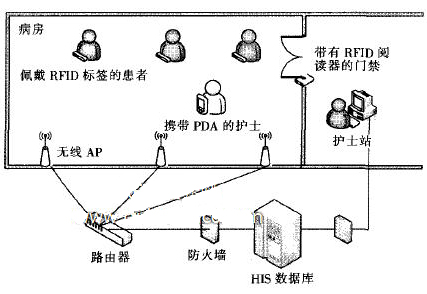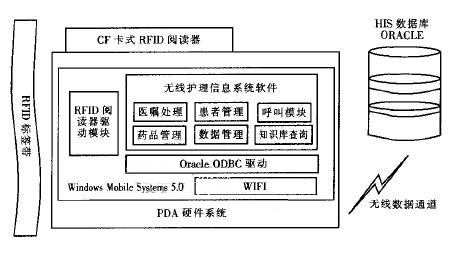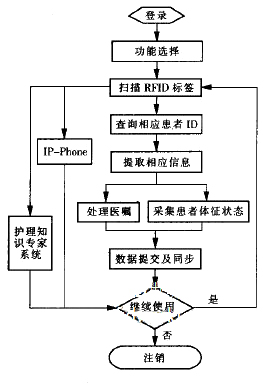Design and implementation of wireless nursing information system based on RFID
1 Introduction
Due to the limitations of technology and objective conditions, the hospital has long been unable to effectively reduce the occurrence of medical errors by taking various measures. In addition to adversely affecting the reputation of medical institutions, medical errors also bring irreparable losses to patients and also cause huge economic losses.
The patient needs to go through three steps from the doctor to the treatment: the doctor checks the patient and draws a preliminary diagnosis after issuing the medical order, the nurse transfers the medical order to the infusion or treatment card and prepares to execute, and the nurse implements the treatment plan. Each of these three steps is crucial. There must be no negligence, otherwise it will lead to medical errors. Medical order information errors can be reflected in the hospital information system, and most of these errors can be discovered and corrected before the nurse executes the medical order. However, the current medical orders from the issuance to execution is an open process. The medical orders issued by doctors are well documented in the information system, but there is no objective real-time record of who executes the medical orders and when they are executed. The verification method is also too simple. The traditional "three checks and seven pairs" method is not ideal for implementation. There are hidden risks of medical errors. Medical errors such as taking the wrong medicine, getting the wrong injection, or even opening the wrong knife often occur.
With the development of wireless network technology and radio frequency identification technology (RFID), combining the two can effectively prevent and avoid the occurrence of medical errors. With the support of wireless network technology and RFID technology on this basis, real-time inspection and confirmation of each step in the execution of medical orders can be achieved, and the unique identification of patient identity, drugs, blood bags, etc. can be completed, which guarantees the patient Safety, improve medical quality and reduce medical errors will play a huge role
This article implements a wireless care information system based on RFID design. By deploying a wireless network in the ward, the patient wears an RFID tag tape and attaches RFID tags to medicines and blood bags. The nurse can directly collect and enter patient information through the PDA handheld computer, such as : Who executes the doctor's orders, when the doctor's orders are executed, the patient's physiological indicators, nursing conditions (medications, temperature measurements, diaper changes, breastfeeding times), etc., connecting IP — PH0NE has a call function, which can effectively ensure that hospital staff Patients are identified quickly and accurately. The patient label tape can also be prevented from being replaced or removed at will, ensuring the uniqueness and correctness of the label object. The system can effectively realize the closed-loop control of the entire process of medical order execution information, prevent and avoid the occurrence of medical errors, thus ensuring the safety of patients.
2 RFlD technology introduction
RFID (Radio Frequencv IdenTIficaTIon) is radio frequency identification, which uses space electromagnetic induction or electromagnetic propagation to communicate, and realizes energy transmission and data transmission according to the timing relationship within the communication link, thereby achieving non-contact target identification and tracking.
The basic working method of the RFID system is to install the RFID tag on the identified object (paste, insert, wear, implant, etc.), when the identified object enters the reading range of the RFID reader. A wireless communication link is established between the tag and the reader. The tag sends its own information to the reader, such as the tag number and tag storage data. The reader receives this information, decodes it, and then transmits it to the background computer for processing to complete the entire information processing process.
RFID does not require a wired reader, and the RFID tag has another function, which allows the information on the tag to be updated. The RFID reader can simultaneously scan multiple label tapes, and each bar code must be read by the corresponding bar code scanner one by one; the linear bar code can only accommodate 1O-20 character data. In contrast, RFID readers are not limited by storage capacity and can store thousands of character data: In addition, RFID tag tapes can be wiped with alcohol, effectively avoiding use in wet environments or being contaminated or worn by blood In other situations, the barcode cannot be read and lose its function, which is more suitable for application in the medical industry.
3 RFID-based wireless nursing information system overall design
3.1 Schematic diagram of working environment
The working environment of the hospital's digital RFID-based wireless nursing information system is shown in Figure 1. The wireless LAN is deployed in the ward, and the wireless AP (Access Point) is deployed according to the working range of the PDA. The patient wears an RFID tag tape, and the nurse carries a PDA with RFID reading function. Information exchange with the HlS through the wireless network. The nurse determines the patient's identity based on the patient's label, and at the same time, confirms the medicine and the like when executing the medical order, and enters the medical order by who, when the medical order is executed, and the patient's sign data, etc., are entered into the H1S through the PDA. At the same time, an access control system is installed in the ward, and patients can automatically respond to the nurse station when they enter and leave the ward, which is convenient for management.

Figure 1 RFlD-based wireless nursing information system working environment design
3.2 Overall system structure
The operating environment of the system is Windows Mobile Svstem 5.0. A CF card-type RFID reader is installed on the PDA, and the data on the label is transmitted to the nursing information system through the driver to realize the unique confirmation of patients and drugs. Nursing information system connects to H1S database through 0racle0DBC driver program, realizes data interaction, and realizes through wireless network on link layer. Nursing information system software is composed of patient management, drug management, medical order processing, data management, knowledge base query and call module. The overall structure of the wireless care information system based on RFID is shown in Figure 2.

Figure 2 The overall structure of a wireless nursing information system based on RFlD
3.3 Functional design
The wireless nursing information system has the following functions
(1) It can scan the RFID tag to uniquely identify the patient's identity and the information corresponding to the medicine.
(2) Can complete the patient's humanities, discharge, transfer, transfer, bed change and corresponding cancellation operations, and can query the patient's mobility.
(3) Enter and query the test form, enter the patient's physical information (such as blood pressure, body temperature, pulse, etc.), enter nursing information and diagnosis information on the first page of the medical record, etc.
(4) Able to complete the operation of medical order entry, proofreading, invalidation, etc., enter the medical order pricing item, realize query and processing according to the patient's medical order, and realize the entry of drug placement.
(5) Implement the patient call module and the IP-PHONE function based on WI, which facilitates the information exchange between nursing staff.
(6) Implement knowledge base query and provide nurses with accurate, fast, convenient, and flexible best channels to obtain nursing knowledge and technology, which can meet the knowledge needs of the majority of nurses, and thus better serve patients' health.
(7) Data management provides data backup and synchronization functions to ensure data security.
4 Implementation of wireless nursing information system based on RFID
4.1 Hardware system implementation
The hardware system of the wireless care system based on RFID mainly includes the following 4 parts:
(1) CF card type RF1D tag reader, the model is set to Compact Flash ReaderKD8, support IS014443A (B), IS0 l5693 standard;
(2) Handheld computer PDA, model is HP iPAQ hx249Oc, operating environment Windows M0bile 5.0:
(3) Wireless access point AP, model GIGABYTE GN-A1] G, protocol is IEEE 8O2.118O2.11b:
(4) RFID label printer, model is Intellitag PM4i, working frequency is 1356 MHz, supports IS0 15693 standard.
4.2 Software system implementation
The RFID-based wireless nursing system software implementation includes a database and application software implementation, in which the database directly uses the related tables in the "Military One" HIS database, including the patient's main index, medical order form, price list, etc. The table to be added is the RFID tag and the patient ID number comparison table in the HIS database, the drug RF1D tag and the medical order comparison table, etc.
The application software uses Microsoft.Net Framework 3.5 SDK. The development language is C #. The development environment is Micmsoff visual Studio 2008. The Sman Device CAB Proiect template is used. The software flow is shown in Figure 3.

Figure 3 Software flow chart
In the process, login and function selection are performed first. Then complete the monitoring of the entire process of the doctor's order according to the selected module, or select the IP-PH0NE function based on WIF1. If you want to implement information query, enter the nursing knowledge expert system. After all operations are finally completed, log off the system.
5 Conclusion
This paper implements a wireless nursing information system based on RFID, realizes the correct identification of patients' identities and medicines, realizes the closed-loop execution of medical orders, and effectively prevents and avoids the occurrence of medical errors. The next step of research should focus on solving the wireless network security in the hospital and the protection of RFID's own information security and patient privacy data.
Sound Proof Generator,Soundproof Diesel Alternator,Ac Alternator,Soundproof Electric Water Diesel Generator
Jiangsu Lingyu Generator CO.,LTD , https://www.lygenset.com